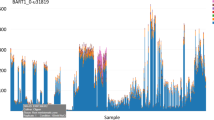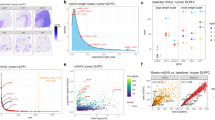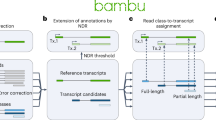Abstract
Although DNA microarrays are currently the standard tool for genome-wide expression analysis, their application is limited to organisms for which the complete genome sequence or large collections of known transcript sequences are available. Here, we describe a protocol for cDNA-AFLP, an AFLP-based transcript profiling method that allows genome-wide expression analysis in any species without the need for prior sequence knowledge. In essence, the cDNA-AFLP method involves reverse transcription of mRNA into double-stranded cDNA, followed by restriction digestion, ligation of specific adapters and fractionation of this mixture of cDNA fragments into smaller subsets by selective PCR amplification. The resulting cDNA-AFLP fragments are separated on high-resolution gels, and visualization of cDNA-AFLP fingerprints is described using either a conventional autoradiography platform or an automated LI-COR system. Observed differences in band intensities between samples provide a good measure of the relative differences in the gene expression levels. Identification of differentially expressed genes can be accomplished by purifying cDNA-AFLP fragments from sequence gels and subsequent sequencing. This method has found widespread use as an attractive technology for gene discovery on the basis of fragment detection and for temporal quantitative gene expression analysis. The protocol can be completed in 3–4 d.
This is a preview of subscription content, access via your institution
Access options
Subscribe to this journal
Receive 12 print issues and online access
$259.00 per year
only $21.58 per issue
Buy this article
- Purchase on Springer Link
- Instant access to full article PDF
Prices may be subject to local taxes which are calculated during checkout




Similar content being viewed by others
References
Cappelli, K. et al. cDNA AFLP-based techniques for studying transcript profiles in horses. Res. Vet. Sci. 79, 105–112 (2005).
Gabriels, S.H. et al. cDNA-AFLP combined with functional analysis reveals novel genes involved in the hypersensitive response. Mol. Plant Microbe Interact. 19, 567–576 (2006).
Guo, J., Jiang, R.H., Kamphuis, L.G. & Govers, F. A cDNA-AFLP based strategy to identify transcripts associated with avirulence in Phytophthora infestans . Fungal Genet. Biol. 43, 111–123 (2006).
Hmida-Sayari, A., Costa, A., Leone, A., Jaoua, S. & Gargouri-Bouzid, R. Identification of salt stress-induced transcripts in potato leaves by cDNA-AFLP. Mol. Biotechnol. 30, 31–40 (2005).
Breyne, P. et al. Transcriptome analysis during cell division in plants. Proc. Natl. Acad. Sci. USA 99, 14825–14830 (2002).
De Paepe, A., Vuylsteke, M., Van Hummelen, P., Zabeau, M. & Van Der Straeten, D. Transcriptional profiling by cDNA-AFLP and microarray analysis reveals novel insights into the early response to ethylene in Arabidopsis. Plant J. 39, 537–559 (2004).
Goossens, A. et al. A functional genomics approach toward the understanding of secondary metabolism in plant cells. Proc. Natl. Acad. Sci. USA 100, 8595–8600 (2003).
Mao, C. et al. Identification of aluminium-regulated genes by cDNA-AFLP in rice (Oryza sativa L.): aluminium-regulated genes for the metabolism of cell wall components. J. Exp. Bot. 55, 137–143 (2004).
Vandenabeele, S. et al. A comprehensive analysis of hydrogen peroxide-induced gene expression in tobacco. Proc. Natl. Acad. Sci. USA 100, 16113–16118 (2003).
Vandeput, F., Zabeau, M. & Maenhaut, C. Identification of differentially expressed genes in thyrotropin stimulated dog thyroid cells by the cDNA-AFLP technique. Mol. Cell. Endocrinol. 243, 58–65 (2005).
Vuylsteke, M., Daele, H., Vercauteren, A., Zabeau, M. & Kuiper, M. Genetic dissection of transcriptional regulation by cDNA-AFLP. Plant J. 45, 439–446 (2006).
Brugmans, B. et al. A novel method for the construction of genome wide transcriptome maps. Plant J. 31, 211–222 (2002).
Reijans, M. et al. Quantitative comparison of cDNA-AFLP, microarrays, and GeneChip expression data in Saccharomyces cerevisiae . Genomics 82, 606–618 (2003).
Velculescu, V.E., Zhang, L., Vogelstein, B. & Kinzler, K.W. Serial analysis of gene expression. Science 270, 484–487 (1995).
Brenner, S. et al. Gene expression analysis by massively parallel signature sequencing (MPSS) on microbead arrays. Nat. Biotechnol. 18, 630–634 (2000).
Liang, P. & Pardee, A.B. Differential display of eukaryotic messenger RNA by means of the polymerase chain reaction. Science 257, 967–971 (1992).
Volkmuth, W. et al. Technical advances: genome-wide cDNA-AFLP analysis of the Arabidopsis transcriptome. OMICS 7, 143–159 (2003).
Vos, P. et al. AFLP: a new technique for DNA fingerprinting. Nucleic Acids Res. 23, 4407–4414 (1995).
Vuylsteke, M., Peleman, J.D. & Van Eijk, M.J.T. AFLP technology for DNA fingerprinting. Nat. Protoc. 2, 1387–1398 (2007).
Bachem, C.W.B. et al. Visualization of differential gene expression using a novel method of RNA fingerprinting based on AFLP: analysis of gene expression during potato tuber development. Plant J. 9, 745–753 (1996).
Bachem, C.W.B., Oomen, R.J.F.J. & Visser, R.G.E. Transcript imaging with cDNA-AFLP: a step-by-step protocol. Plant Mol. Biol. Rep. 16, 157–174 (1998).
Breyne, P. & Zabeau, M. Genome-wide expression analysis of plant cell cycle modulated genes. Curr. Opin. Plant Biol. 4, 136–142 (2001).
Vos, P. & Stanssens, P. AFLP-based transcript profiling. In Current Protocols in Molecular Biology (ed., Ausubel, F.M. et al.), Suppl. 57: 25B.5.1–25B.5.16 (John Wiley & Sons, New York, 2002).
Bikandi, J., San Millan, R., Rementeria, A. & Garaizar, J. In silico analysis of complete bacterial genomes: PCR, AFLP-PCR and endonuclease restriction. Bioinformatics 20, 798–799 (2004).
Kivioja, T., Arvas, M., Saloheimo, M., Penttila, M. & Ukkonen, E. Optimization of cDNA-AFLP experiments using genomic sequence data. Bioinformatics 21, 2573–2579 (2005).
Qin, L. et al. GenEST, a powerful bidirectional link between cDNA sequence data and gene expression profiles generated by cDNA-AFLP. Nucleic Acids Res. 29, 1616–1622 (2001).
Bove, J. et al. Gene expression analysis by cDNA-AFLP highlights a set of new signaling networks and translational control during seed dormancy breaking in Nicotiana plumbaginifolia . Plant Mol. Biol. 57, 593–612 (2005).
Yang, L. et al. cDNA-AFLP analysis of inducible gene expression in rice seminal root tips under a water deficit. Gene 314, 141–148 (2003).
Fusco, N., Micheletto, L., Dal Corso, G., Borgato, L. & Furini, A. Identification of cadmium-regulated genes by cDNA-AFLP in the heavy metal accumulator Brassica juncea L. J. Exp. Bot. 56, 3017–3027 (2005).
Eckey, C. et al. Identification of powdery mildew-induced barley genes by cDNA-AFLP: functional assessment of an early expressed MAP kinase. Plant Mol. Biol. 55, 1–15 (2004).
Durrant, W.E., Rowland, O., Piedras, P., Hammond-Kosack, K.E. & Jones, J.D. cDNA-AFLP reveals a striking overlap in race-specific resistance and wound response gene expression profiles. Plant Cell 12, 963–977 (2000).
Valverde, A., Okon, Y. & Burdman, S. cDNA-AFLP reveals differentially expressed genes related to cell aggregation of Azospirillum brasilense . FEMS Microbiol. Lett. 265, 186–194 (2006).
Decorosi, F., Viti, C., Mengoni, A., Bazzicalupo, M. & Giovannetti, L. Improvement of the cDNA-AFLP method using fluorescent primers for transcription analysis in bacteria. J. Microbiol. Methods 63, 211–215 (2005).
Noel, L., Thieme, F., Nennstiel, D. & Bonas, U. cDNA-AFLP analysis unravels a genome-wide hrpG-regulon in the plant pathogen Xanthomonas campestris pv. vesicatoria . Mol. Microbiol. 41, 1271–1281 (2001).
Rombauts, S., Van de Peer, Y. & Rouzé, P. AFLPinSilico, simulating AFLP fingerprints. Bioinformatics 19, 776–777 (2003).
Chalhoub, B.A. et al. Silver staining and recovery of AFLP amplification products on large denaturing polyacrylamide gels. BioTechniques 22, 216–218 (1997).
Acknowledgements
We are grateful to H. Van den Daele and I. Vercauteren for their help in writing the manuscript, and to Alain Goossens for being so kind as to provide the gel image of C. roseus. The AFLP and cDNA-AFLP technology are covered by patents and patent applications owned by Keygene N.V. AFLP and AFLP-QuantarPro are registered trademarks of Keygene N.V. All other product names, brand names or company names are used for identification purposes only and may be (registered) trademarks of their respective owners.
Author information
Authors and Affiliations
Corresponding author
Ethics declarations
Competing interests
M.J.T. van Ejik and J.D. Peleman are full-time employees of Keygene N.V.
M. Vuylsteke declares not to have competing interests.
Rights and permissions
About this article
Cite this article
Vuylsteke, M., Peleman, J. & van Eijk, M. AFLP-based transcript profiling (cDNA-AFLP) for genome-wide expression analysis. Nat Protoc 2, 1399–1413 (2007). https://doi.org/10.1038/nprot.2007.174
Published:
Issue Date:
DOI: https://doi.org/10.1038/nprot.2007.174
This article is cited by
-
Next-Generation Sequencing in Medicinal Plants: Recent Progress, Opportunities, and Challenges
Journal of Plant Growth Regulation (2024)
-
Assessment of the genetic variations of sago palm Metroxylon sagu in three regions of Sarawak, Malaysia using amplified fragment length polymorphism (AFLP) marker
Chemical and Biological Technologies in Agriculture (2022)
-
Nonhost resistance EST profiling of wheat interacting with Blumeria graminis f. sp. hordei identifies genes for durable resistance to powdery mildew
European Journal of Plant Pathology (2022)
-
Transcript profiling leads to biomarker identification for agarwood resin-loaded Aquilaria malaccensis
Trees (2021)
-
Genetic and epigenetic variations in barley (Hordeum vulgare L.) using SSR and MSAP approaches
Genetic Resources and Crop Evolution (2021)
Comments
By submitting a comment you agree to abide by our Terms and Community Guidelines. If you find something abusive or that does not comply with our terms or guidelines please flag it as inappropriate.



